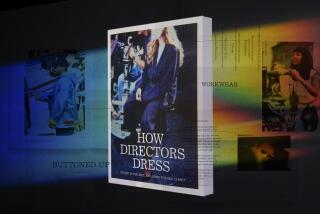Players Giving Golfwear a New Look
- Share via
Anthony Wamsley lines up his putt on the fourth green wearing khaki Bugle Boy shorts, a multicolored Cross Colours baseball shirt and Puma sneakers.
“Not your standard golf clothes,” says the 26-year-old auto parts salesman, who took up the sport eight months ago and pays $16 per round ($20.50 on weekends) to play at Harding Golf Course in Griffith Park. “But, hey, it’s a lot better than all that polyester stuff.”
It seems that bad memories of “that polyester stuff”--the plaid Sansabelt slacks and clingy knit shirts of decades past--have steered a new generation of players away from anything hinting of golfwear.
“A lot of people just wear their normal, everyday clothes on the golf course now,” says Massimo Iacoboni, fashion director of the trend-watching New York-based Fashion Assn. “There is no longer that clear definition between golfwear and sportswear.”
Makers of golf apparel agree, noting that their market has split over the last few years into two camps.
The first group plays regularly and demands functional clothing: pants, shorts or skirts with deep pockets to hold balls, loose cotton-knit shirts with wide armholes, vests with multiple pockets, and wind- and water-resistant jackets and pants. The second, more cost-conscious faction wants separates that double as casual work or weekend wear: cotton trousers, shirts, vests, sweaters and sweat shirts. Items in the latter category tend to be slightly less expensive, in the $30 to $40 range for a shirt.
This broader definition of golfwear has made for a wider range of labels, including Reebok, Cross Creek, Levi’s Dockers, Ixspa 2000, Hathaway, Pivot Rules and Membership Bounce.
“Some are coming out with lines geared specifically for golf while others are just using golf motifs so their customers can show the world they play golf. It’s kind of a status thing,” Iacoboni says.
What these apparel makers have in a common is clothing--in non-threatening colors--that moves freely and breathes. Any trace of miracle fabrics in pastels or neons could scare off a huge gallery of younger buyers.
According to Judy Thompson of the National Golf Foundation, more than half of the 24.5 million men and women who play golf each year are 18 to 39. And the number of junior players, ages 12 to 17, has increased about 5% annually since 1988, making this group the sport’s fastest-growing segment.
The adolescents, both boys and girls, are taking golfwear to new depths. Cutoffs, collarless baseball shirts, halter tops, swimsuits and even Birkenstocks are ubiquitous on local fairways. Jamie Sadock, designer of the Ixspa 2000 collection of golf apparel, describes the look as “modified grungewear.”
Such defiance of tradition is, of course, discouraged among the sport’s elite.
“You won’t see the baggy shorts, T-shirts and unlaced tennis shoes at any of the private clubs,” says David Mehl, owner of Beverly Hills Golf, a store that caters to serious--and affluent--golfers. “Most have some kind of dress codes.”
The rules at the for-members-only Riviera, Lakeside, Bel Air and the Los Angeles country clubs, for example, require shirts with collars and dress slacks for men and Bermuda-length shorts (or skirts) for women. And proper footwear.
Even the public courses do their best to discourage inappropriate shoes, which can mangle the turf.
“We’ve had problems with people wearing baseball shoes with rubber cleats,” says Cathy Sullivan, manager of the Woodley Lakes Golf Course in Van Nuys. The venue’s only dress-related dictum prohibits anything except sneakers or golf shoes, spiked or unspiked, with a minimum 1 3/4-inch-wide heel.
As for clothing, “we’ve seen everything from men in wrinkled dress shirts to (a famous actor) in his bright red Speedos,” Sullivan says.
Although some traditionalists may cringe at such unconventional attire, others believe a more relaxed approach to the game is at least partly responsible for attracting young players. Thompson, of the National Golf Foundation, also credits the accessibility of such alternative facilities as Scandia Fun Center, where putting greens and interactive golf-game simulators are among the attractions.
Women are also coming to the sport in record numbers, she says, many of them mindful that business deals have long been sealed on the nation’s courses.
In creating golfwear for these women, some designers have looked to the runways for inspiration.
“We’ve introduced a lot of new design elements to women’s golf--cropped cardigans, sarong and denim skirts, bodysuits with collars--that are also functional,” says Courtney Taylor, design director for New York-based Pivot Rules. “The bodysuit, for instance, ensures everything is going to stay in place when she swings.”
Levi Strauss and Reebok have also taken up the task of making golf clothes more contemporary.
At Levi, Dockers Golf is in its infancy. Limited so far to shirts in solid, print and Jacquard knits sold at major department stores, the collection will expand over the next few years to include sturdy but lightweight cotton twill slacks and shorts with deeper pockets, as well as outerwear.
Reebok is among a number of companies that have enlisted professional pitchmen. It signed pro tour veteran Greg Norman to tout its anti-’70s styles, merchandise manager Billy Burch says.
“Unlike the typical striped golf shirts and plaid trousers or ‘Caddyshack’ looks, we came out with bold, aggressive, colorful print shirts you might see in sportswear but never in golf.”






